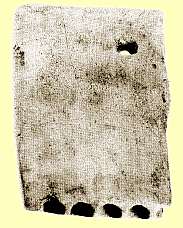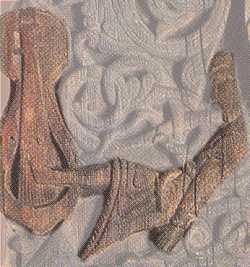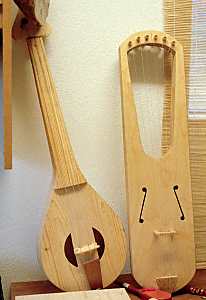
|

|
Music of the Viking Age
 |
If people in the Viking lands created and enjoyed music, they left little behind to prove it. Other European lands in the Viking age left behind extensive evidence of music. We find the instruments themselves, descriptions of instruments, stories about instruments, and pictures of instruments, such as the harp shown to the left in an Anglo-Saxon manuscript from around the year 1000. |
However, in the Viking lands, the literary and archaeological records supporting the presence of music are very slight. In the later part of the era, after the conversion to Christianity, the records are more clear, and it is likely that music was as much a part of Christian life in Norse lands as anywhere else in Europe. However, for the early part of the era, little evidence exists that tells us about the type of music performed or about the instruments on which it was performed.
One might expect that at least a few Viking era musical instruments would survive. One one hand, the organic materials from which instruments were made are unlikely to remain intact after centuries of burial. On the other hand, unusual conditions have permitted a large number of other organic artifacts to have survived. Regardless, few musical instruments or parts of instruments have been found from the Viking age in Viking lands.
 |
Among the most convincing musical instrument find is the 10th century bone flute found at Birka (left), which remains playable today. Other notable artifacts include a portion of a 10th century set of wooden pan pipes found at York (right), and the 9th century amber bridge from an unknown six stringed instrument found in a burial at Broa. |
 |
This is in stark contrast to the hundreds of other bone artifacts (such as combs and needles), and the thousands of wood artifacts that have been found. The scarcity suggests that musical instruments simply were not very common in Viking lands.
The literary record is even more confusing. From stories that take place later in the Norse era, we learn that men of accomplishment prided themselves on their musical abilities. For example, Earl Rögnvaldr Kali Kolsson claimed to have mastered music and verse in chapter 58 of Orkneyinga saga. Morkinskinna records a verse by King Haraldr haršrįši in which he claims to have mastered harp-playing and poetry.
Musical instruments are rarely mentioned in the Norse literature. Perhaps one of the most familiar examples is the story of Gunnar, described in both Atlakviša (verse 31) and Atlamįl (verse 66). Atli threw Gunnar into a snake pit. To calm the snakes, Gunnar played his harp, but to no avail. In Atlamįl, it is said that Gunnar played the harp with his toes, presumably because his hands were bound. This scene is depicted on the stave church portal from Hylestad, carved at the beginning of the 13th century (right). |
 |
Another harp is mentioned in Voluspį (verse 42), played by a giantesss herdsman. In chapter 4 of Viglundar saga, it is said that Earl Eirķkur entertained King Haraldur with various music, both songs and stringed instruments. In chapter 7 of Bįršar saga Snęfellsįss, Helga played the harp all night in her bed. In chapter 3 of Jökuls žįttur Bśasonar, Jökull was entertained with songs and bassoon music while visiting King Soldan in the land of the Saracens. Horns (lśšr) were blown to call men to battle, such as in chapter 9 of Vatnsdęla saga.
| A Viking-age picture stone in Gotland is purported to show a lyre. GP 34 Boge Laxarve 2 is a fragment, showing a ship with warriors aboard, a woman hovering above the ship interpreted as a valkyrie, and a figure thought to be a lyre. |
In the Sagas of Icelanders, Christian mass is sung (Brennu-Njįls saga chapter 124 and others), weapons sing (a sword, an axe, and a halberd in chapters 30, 44, 54, and 79 of Brennu-Njįls saga), but rarely do people sing. Two familiar examples are frequently cited.
In chapter 4 of Eirķks saga rauša, Gušrķšr was urged to help a sorceress. Even though she knew the varšlokkur (ward chants), she was reluctant to participate, because she was a Christian. Ultimately, she spoke the chant beautifully. In chapter 37 of Laxdęla saga, the sorceress Grima practiced her magic, speaking chants that were sweet to the ear. In both cases, magic rites (seišur) were being performed, and the chants were an integral part of the rites.
Perhaps the most convincing example of singing comes from chapter 87 and 88 of Grettis saga. While imprisoned in Byzantium, Žorsteinn sang songs to keep his spirits high. His fine voice attracted the attention of Spes, who arranged his release.
After the conversion to Christianity near the end of the Viking era, music would more certainly have been a part of daily life. Music in the church in Norse lands would have been the same as anywhere else in Europe at the time: psalms and hymns were sung as part of daily worship.
One expects that if singing and music were an important part of daily life in the Norse era, more evidence of it would have survived, both in the literature and in the archaeological records. However, the lack of evidence proves little. The best we can say is that we simply do not know whether music was performed or not. We do not know the nature of the performances nor the nature of the instruments on which it was performed.
 |
Despite the sparse evidence, talented instrument makers and musicians have created replica Viking-age instruments and used them in performances with very interesting and entertaining results. On the left is a photo of replicas of stringed instruments, and on the right, various wind instruments created by Jón Siguršsson. |
 |
|
|
©2001-2025 William R. Short |